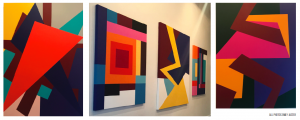The old movie theater on Wisconsin and O street sits right in the middle of Georgetown, its recognizable neon sign lighting up the sidewalk below. The space, opened in 1913 as the Dumbarton Theatre, was recently remodeled with the idea of a commercial or retail space in mind, but is still looking for a permanent inhabitant after its closure over 30 years ago. Briefly last month, it was home to art dealership Closed Monday Production’s pop-up gallery, the Art of Legacy exhibition, showcasing abstract art and surrealist photography.
The space feels perfect for a gallery due to its long, open structure and copious natural lighting. A partially-exposed downstairs area allows for an organic break in collections while maintaining a united theme. In the expansive yet intimate gallery the pieces on display are seen as part of a whole, inviting viewers to grasp the work without spatial obstructions.

“Portlandia,” Raymond Kaskey (Photo Source: Claire Goldberg)
When you first walk into the gallery, a metal sculpture of a woman crouching with a trident sits atop a white pillar directly to your left. The piece, entitled “Portlandia,” is the only sculpture in the entire space, standing out in its realism amongst abstractions. Behind it is a singular, brightly colored painting, hanging alone in the front window. And rightfully so. “Come Fly With Me,” by Barbara Januszkiewicz, is fresh and floral, distinctive with its glossy surface and a stark contrast of blues, oranges, and purples. It is the prime piece to lure in passersby.
Januszkiewicz’s collection, a continuation of the theme in “Come Fly With Me,” is one of the highlights of the gallery, reminiscent of springtime buds and blooms. Her works are accompanied in the pop-up by those of Anne Marchand, whose tie-dye-esque abstractionist paintings are exceedingly vibrant, appearing almost intergalactic. The two artists evoke similar feelings from their use of explosive styles and vivid hues, an obvious nod to the season. Both rely on color and abstraction to create conceptual meaning, but they stand alone, distinct in their own right. Januszkiewicz’s paintings are constructive and translucent, inviting more layers, while Marchand’s works are reductive and solid, as if the paint is melting away.
Januszkiewicz covers metal plates of various sizes with ceramic or glass-like coatings. These glossy surfaces make the vivid, juxtaposed colors of her abstracts erupt in bursts of emotion. From afar, the images look like tulips. Her paintings emit tremendous light and motion, creating an overwhelming sense of happiness.
Marchand’s work is spectacular. The technique behind each piece is very similar, making it look as if the paint is still in its liquid form, in the process of being dyed or washed away. But this doesn’t contribute to any sort of stylistic redundancy. The canvases are all the same size, but the variation in color and composition gives the pieces individual prominence. No two swirls, spins, or splotches are the same.
One of Marchand’s stand-out pieces is “Counterpoint,” which is mostly white space, lightly splattered with green, yellow, and purple. The work gives the illusion of melting, as if it is transitioning back into a blank canvas. It sits in opposition to all the other pieces, which are strikingly full of a variety of colors, hardly any blank canvas left to see. However, the juxtaposition of swirling motion despite its two-dimensional plane and relative emptiness gives it fullness and life.
Another artist on display is abstractionist John Blee, whose paintings are pleasant, although they do not stand out as much as those of Januszkiewicz and Marchand. All of his works except one are downstairs, and after seeing the bright, wide variety of colors in Marchand and Januszkiewicz’s art, they pale in comparison. The color choices are dimmer and the technique heavier. On top of this, Blee’s collection lacks an overall stylistic cohesion, unlike his two peers.
The photography in the gallery is imaginative, but not incredibly compelling. Marissa White’s surrealist photos are intriguing: the best work depicts hands holding monarch butterflies underwater, and a cheerful photograph shows a headless woman in a pink dress with bubbles emerging from the area where her neck should be. However, none of her photographs are incredibly thought-provoking. Like Blee’s paintings, the colors of the photographs are darker and dimmer than those of the abstract paintings hung on the opposite wall. They feel static, juxtaposed with the active, motion-driven paintings.
Although the Art of Legacy exhibition is no longer in existence, Closed Monday will be opening another gallery in May. The idea of a pop-up exhibition allows for a natural cycle of creativity, with fresh takes on collections rotating in the right space. Though it’s hard to see some of the works go so fast, it’s comforting to know that many new artists and curators will have the chance to express their creativity. The pieces invited passersby, at least for a moment, to escape the hectic streets of Georgetown and reflect on the rapidly departing season.





